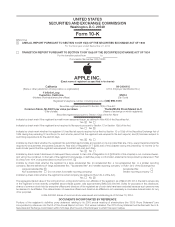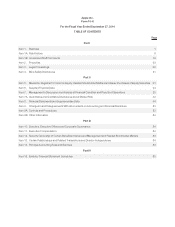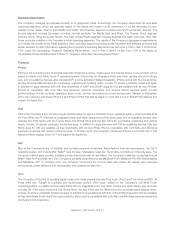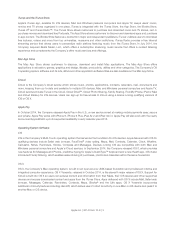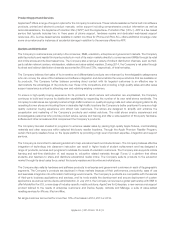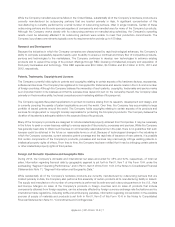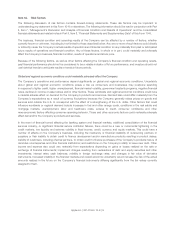Apple 2014 Annual Report Download - page 4
Download and view the complete annual report
Please find page 4 of the 2014 Apple annual report below. You can navigate through the pages in the report by either clicking on the pages listed below, or by using the keyword search tool below to find specific information within the annual report.Business Organization
The Company manages its business primarily on a geographic basis. Accordingly, the Company determined its reportable
operating segments, which are generally based on the nature and location of its customers, to be the Americas, Europe,
Greater China, Japan, Rest of Asia Pacific and Retail. The Americas segment includes both North and South America. The
Europe segment includes European countries, as well as India, the Middle East and Africa. The Greater China segment
includes China, Hong Kong and Taiwan. The Rest of Asia Pacific segment includes Australia and Asian countries, other than
those countries included in the Company’s other operating segments. The results of the Company’s geographic segments do
not include the results of the Retail segment. Each operating segment provides similar hardware and software products and
similar services. Further information regarding the Company’s operating segments may be found in Part II, Item 7 of this Form
10-K under the subheading “Segment Operating Performance,” and in Part II, Item 8 of this Form 10-K in the Notes to
Consolidated Financial Statements in Note 11, “Segment Information and Geographic Data.”
Products
iPhone
iPhone is the Company’s line of smartphones that combines a phone, music player and internet device in one product, and is
based on Apple’s iOS Multi-Touch™ operating system. iPhone has an integrated photo and video camera and photo library
app, and on qualifying devices, also includes Siri®, a voice activated intelligent assistant. iPhone works with the iTunes Store,
the App Store and iBooks Store for purchasing, organizing and playing music, movies, TV shows, podcasts, books and apps.
In addition to apps delivered with iOS, free downloads of iLife®and iWork®apps for iOS are available with all new iPhones.
iPhone is compatible with both Mac and Windows personal computers and Apple’s iCloud services which provide
synchronization of mail, contacts, calendars, apps, music, photos, documents and more across users’ devices. In September
2014, the Company introduced iPhone 6 and iPhone 6 Plus that feature larger 4.7-inch and 5.5-inch Retina®HD displays and
support for Apple Pay.
iPad
iPad is the Company’s line of multi-purpose tablets based on Apple’s iOS Multi-Touch operating system, which includes iPad
Air™ and iPad mini™. iPad has an integrated photo and video camera and photo library app, and on qualifying devices, also
includes Siri. iPad works with the iTunes Store, the iBooks Store and the App Store for purchasing, organizing and playing
music, movies, TV shows, podcasts, books and apps. In addition to apps delivered with iOS for qualifying devices, iLife and
iWork apps for iOS are available as free downloads with all new iPads. iPad is compatible with both Mac and Windows
personal computers and Apple’s iCloud services. In October 2014, the Company introduced iPad Air 2 and iPad mini 3 that
feature a Retina display, Touch ID™ and support for Apple Pay.
Mac
Mac is the Company’s line of desktop and portable personal computers. Macs feature Intel microprocessors, the OS X
operating system and include Mail, Safari®web browser, Messages, Calendar, Reminders, Contacts and the iLife apps. The
Company’s iWork apps are also available as free downloads with all new Macs. The Company’s desktop computers include
iMac®, Mac Pro®and Mac mini. The Company’s portable computers include MacBook Pro®, MacBook Pro with Retina display
and MacBook Air®. In October 2014, the Company introduced the 27-inch iMac with Retina 5K display with improved
performance, power efficiency and visual quality; and updated the Mac mini.
iPod
The Company’s iPod line of portable digital music and media players includes iPod touch, iPod nano®and iPod shuffle®. All
iPods work with iTunes®to purchase and synchronize content. iPod touch, based on the Company’s iOS Multi-Touch
operating system, is a flash-memory-based iPod with an integrated photo and video camera and photo library app, and also
includes Siri. iPod touch works with the iTunes Store, the App Store and the iBooks Store for purchasing and playing music,
movies, TV shows, podcasts, books and apps. In addition to apps delivered with iOS, iLife and iWork apps for iOS are available
as free downloads for all new iPod touch products. iPod touch is compatible with both Mac and Windows personal computers
and Apple’s iCloud services.
Apple Inc. | 2014 Form 10-K | 2

